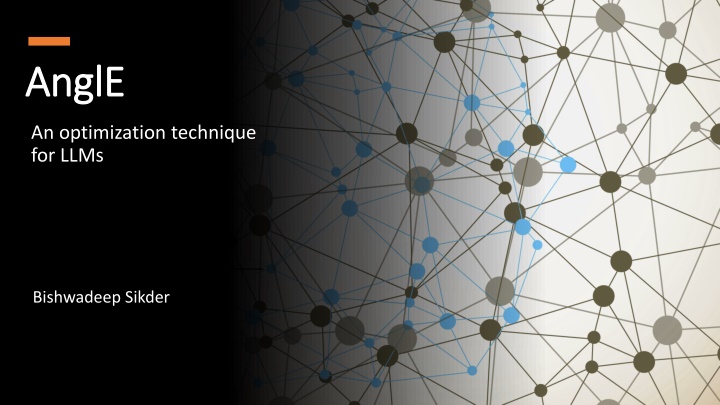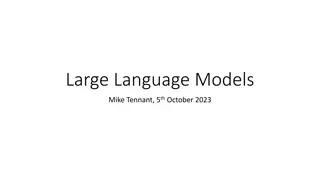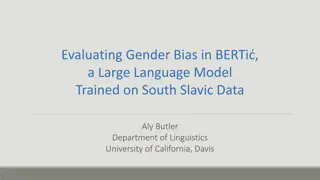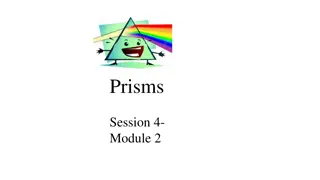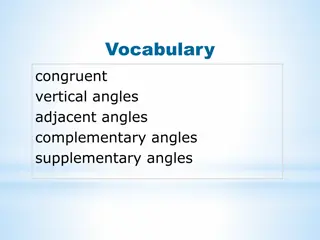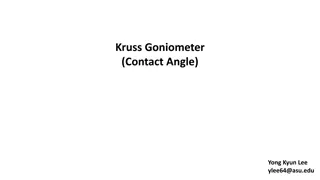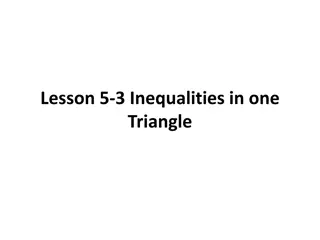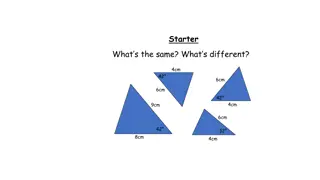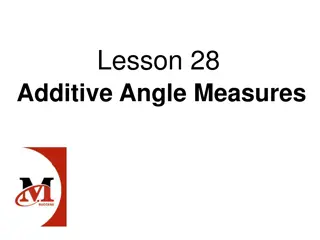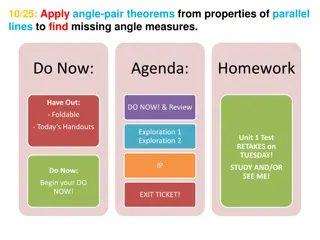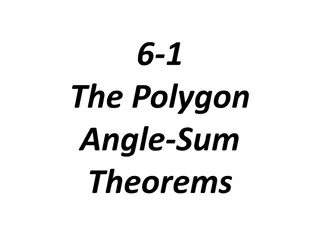AnglE: An Optimization Technique for LLMs by Bishwadeep Sikder
The AnglE model introduces angle optimization to address common challenges like vanishing gradients and underutilization of supervised negatives in Large Language Models (LLMs). By enhancing the gradient and optimization processes, this novel approach improves text embedding learning effectiveness. It incorporates three losses - cosine objective, in-batch negative objective, and angle objective - resulting in higher Spearman Correlation Coefficient scores in STS benchmark datasets for both transfer and non-transfer tasks.
Download Presentation

Please find below an Image/Link to download the presentation.
The content on the website is provided AS IS for your information and personal use only. It may not be sold, licensed, or shared on other websites without obtaining consent from the author.If you encounter any issues during the download, it is possible that the publisher has removed the file from their server.
You are allowed to download the files provided on this website for personal or commercial use, subject to the condition that they are used lawfully. All files are the property of their respective owners.
The content on the website is provided AS IS for your information and personal use only. It may not be sold, licensed, or shared on other websites without obtaining consent from the author.
E N D
Presentation Transcript
AnglE AnglE An optimization technique for LLMs Bishwadeep Sikder
Common problems with current LLMs Vanishing Gradients Due to Cosine Function: Many existing text embedding models, especially those used in Large Language Model (LLM) applications, face the issue of vanishing gradients. This problem is primarily due to their reliance on the cosine function in the optimization objective. Underutilization of Supervised Negatives: Existing models that utilize pre-trained language models (like BERT and RoBERTa) in combination with contrastive learning face limitations in supervised settings. These models often underutilize supervised negatives and rely on in-batch negatives, which can be inaccurate without proper annotation. This leads to performance degradation.
Contributions of AnglE The AnglE model introduces angle optimization in a complex space, effectively mitigating the adverse effects of the saturation zone in the cosine function. This novel approach improves the gradient and optimization processes, allowing for more effective learning of text embeddings. The identical sentences within a batch that are not explicitly labeled as positive samples are considered as in-batch negatives. These duplicate sentences are identified and assigned as positive samples. The introduction of the three losses namely cosine objective, in-batch negative objective and angle objective enables a higher Spearman Correlation Coefficient score in STS benchmark datasets in both transfer and non-transfer tasks. Since STS only comprises short text sentences, for a fair evaluation, a newly-introduced dataset consisting of long sentences, GitHub Issues Similarity Dataset has been used as well as a non- transfer task.
Input Layer Padding: The input sentences are first subjected to padding. This step ensures that all sentences have a consistent length, denoted as l. Word Embeddings: Each word in the sentence is then mapped to a continuous d-dimensional space to produce word embeddings. These embeddings are denoted as ei where i represents the word's position in the sentence. Concatenation: The word embeddings for each sentence are concatenated to form the model input. This can be represented as E=[e1, e2, ,el] Rl d Passing Through Encoder: The model input E is then passed through an encoder which is a pre- trained language model such as BERT, RoBERTa, or LLaMA which transforms the initial word embeddings into contextualized representations. Contextual Representation: The output of this process is the contextual representation X.
Cosine Objective According to the CoSENT paper, the cosine similarity of positive samples should be as large as possible, and the cosine similarity of negative samples should be as small as possible. This is the basis on which the cosine function has been created and is used for generalization and end-to-end optimization of cosine similarity between representations. - Temperature Hyperparameter cos( ) - Cosine Similarity Function s(u, v) - Similarity between vectors u and v
In-Batch Negatives The concept of in-batch negative samples is related to the training strategy, especially in the context of contrastive learning or when optimizing embedding spaces. Positive Pairs: Within a training batch, for a given data point (e.g., a sentence), its positive pair is typically another data point that is semantically similar or related based on the task (e.g., another sentence that it entails in the context of NLI). Negative Pairs: Negative pairs are pairs of data points that are not supposed to be similar or related. In the case of in-batch negatives, these negative pairs are constructed using other data points present in the same batch. Constructing In-batch Negatives: If the batch size is N, and for each example in the batch, the other N-1 examples are treated as potential negatives. This is under the assumption that randomly chosen examples from the dataset are unlikely to be similar or related (especially true for large and diverse datasets like NLI).
In-Batch Negatives: Example Batch of Sentences: Consider a batch with four sentences - S1, S2, S3, S4. Let us assume S1 and S2 are semantically similar, and S3 and S4 are another pair of semantically similar sentences. In-Batch Negatives: In traditional contrastive learning, S3 and S4 would be considered in-batch negatives for S1, as they are different and not explicitly labeled as positive pairs with S1. Objective Function: The model would use a cosine similarity-based objective to maximize the similarity between S1 and S2 and minimize it between S1 and the in-batch negatives S3 and S4. AnglE Approach: AnglE acknowledges the potential issue with in-batch negatives. It recognizes that without proper annotation, it's uncertain whether S3 and S4 are truly negatives for S1.
In-Batch Negatives: Objective Function The in-batch negative objective function then uses these in-batch negatives to calculate the loss, encouraging the model to learn embeddings such that positives are closer together and negatives are farther apart in the embedding space. In normal contrastive models, positive samples are generated through data augmentation whereas, in here supervised positive samples are used. - Temperature Hyperparameter b - Batch number X+biand X+bj - Positive Samples of Xbi and Xbj m - Number of Positive Pairs in bth batch N - Batch Size cos( ) - Cosine Similarity Function
Angle Optimization Central to the AnglE model, this objective aims to optimize the angle difference in complex space. It's a novel approach designed to overcome the limitations of the cosine function's saturation zone. Process: Both the cosine and in-batch negative objectives employ the cosine function to measure similarity. However, it is important to note that the cosine function includes saturation zones, which can hinder the optimization process. Instead of relying solely on cosine similarity, this function introduces a complex space where angles between vectors are optimized. By focusing on angle differences, the model avoids the saturation problem of cosine similarity, where gradients can vanish.
Angle Optimization: Objective Function This objective focuses on optimizing the angle difference in complex space to address the limitations of the cosine similarity function, particularly its saturation zones. - Temperature Hyperparameter s(u, v) - Similarity between vectors u and v By optimizing the Langle, the main objective is to minimize the normalized angle difference for pairs with high similarity compared to those with low similarity.
Total Loss Combination of the three objective functions according to their weightages. w1, w2, and w3 are constants
Temperature Hyperparameters () Cosine Objective: The temperature hyperparameter controls the smoothness of the Softmax function, essentially scaling the differences between the cosine similarities of the pairs. A lower makes the model more confident (but potentially more prone to overfitting), whereas a higher results in softer probability distributions over pairs. In-Batch Negative Objective: The temperature hyperparameter in this context is similarly used to scale the differences in similarity measures, aiding in distinguishing between negative and non- negative pairs within the batch. Angle Objective: The temperature hyperparameter in the angle objective serves a similar purpose in scaling the differences between angle similarities.
Pretraining and Hyperparameter Values The pre-trained uncased BERT base model (110M parameters) as the backbone model. Based on prior research papers, for the cosine objective and the in-batch negative objective to 0.05. Based on Grid search, for the angle objective is set to 1.0.
Transfer Tasks In transfer tasks, the AnglE model is first trained on Natural Language Inference (NLI) datasets, specifically MNLI (Williams et al. 2018) and SNLI (Bowman et al. 2015). After training, the model is then "transferred" to evaluate seven Semantic Textual Similarity (STS) benchmark datasets. This approach tests the model's ability to generalize and apply its learned knowledge to different but related tasks. AnglE, with its supervised cosine objective and in-batch negative objective, along with angle optimization, shows better performance in these transfer tasks compared to other baselines, indicating good generalization capabilities
Non-Transfer Tasks Non-transfer tasks involve training and evaluating the model on the same types of tasks and datasets. The training is done for the baselines on the train set and evaluated on the test or validation set. This approach is used to evaluate the intrinsic learning and performance capabilities of the model on specific tasks without the influence of knowledge transferred from different tasks. The paper evaluates the models on four short-text datasets (MRPC, STS-B, QQP, and QNLI) and one long-text dataset (GitHub Issues Similarity Dataset) in the non-transfer setting. The performance of models like SimCSE is noted to be poorer in the non-transfer setting compared to AnglE and SBERT, likely due to the limitations of the training set and the nature of the provided data.
Ablation Study The paper discusses an ablation study based on the following objectives on AnglE-BERT: Applying all objectives on AnglE-BERT Using Cosine and In-Batch Negative objectives Using Cosine and Angle objectives Using only Cosine objective Using only In-Batch Negative objective Using only Angle objective The paper also talks about an ablation study based on the choice of pooling strategies and it is shown that the highest performance is achieved by the CLS Token Pooling (Classification Token).
Self-Experiment: Classification Task on SentEval Datasets A classification comparison has been done between the BERT based models including AnglE optimization. The following datasets from SentEval have been chosen: Movie Reviews (MR), Customer Reviews (CR), Opinion Polarity (MPQA), Subjectivity / Objectivity (SUBJ) and Stanford Sentiment Treebank (SST). Embeddings of the sentences have been generated using the following models: 'BERT', 'RoBERTa', 'DistilBERT', 'DistilRoBERTa', 'MultiQA', 'MiniLM', 'Paraphrase-MiniLM', 'SBERT', 'SimCSE , and AnglE optimized models, 'AnglE-Universal', 'AnglE-Llama', 'AnglE-BERT . These embeddings have been passed through a few classifiers: 'Naive Bayes (Bernoulli)', 'Random Forest', 'K-Nearest Neighbors', 'Logistic Regression , and 'Support Vector Machine Classification Accuracy and F1-Scores are determined based on the supervised labels of each dataset and reported.
Self-Experiment: Classification Task on SentEval Datasets Results
Self-Experiment: Classification Task on SentEval Datasets Results Box Plot
Self-Experiment: Classification Task on SentEval Datasets Results Performance Comparison
Self-Experiment: STS Tasks Like the classification tasks, all the models discussed in the previous slides have been employed. 7 datasets from the STS evaluation has been chosen namely STS12 STS16, SICK-R and STS-B. Embeddings for all the sentence pairs have been determined for each dataset by each model. Cosine Similarity for each sentence pair embedding has been calculated. Finally, Spearman s Rank Correlation Coefficient has been calculated and compared for each model, for each dataset.
Training Process This code is used to train the model using AnglE API
Testing Process This is the code for testing the trained model, for generating embeddings for sentence pairs, calculating Cosine Similarity and Spearman s Rank Correlation Coefficient.
Example of Class Separation Improvement (PCA) BERT vs AnglE-BERT CR - BERT CR AngleE-BERT MPQA - BERT MPQA AngleE-BERT SUBJ AngleE-BERT SUBJ - BERT MR - BERT MR AngleE-BERT
Ongoing Work Creating miniature forms of the objective functions based on the mathematics explained in the paper, to avoid using the AnglE API for better customizability and modularity. Instead of taking BERT as the backbone of angle optimization, experiment with SBERT and SimCSE as the backbone, and application of angle optimization on them. Coming up with mathematical objectives or post embedding transformations for better class separation and Spearman s Rank.
